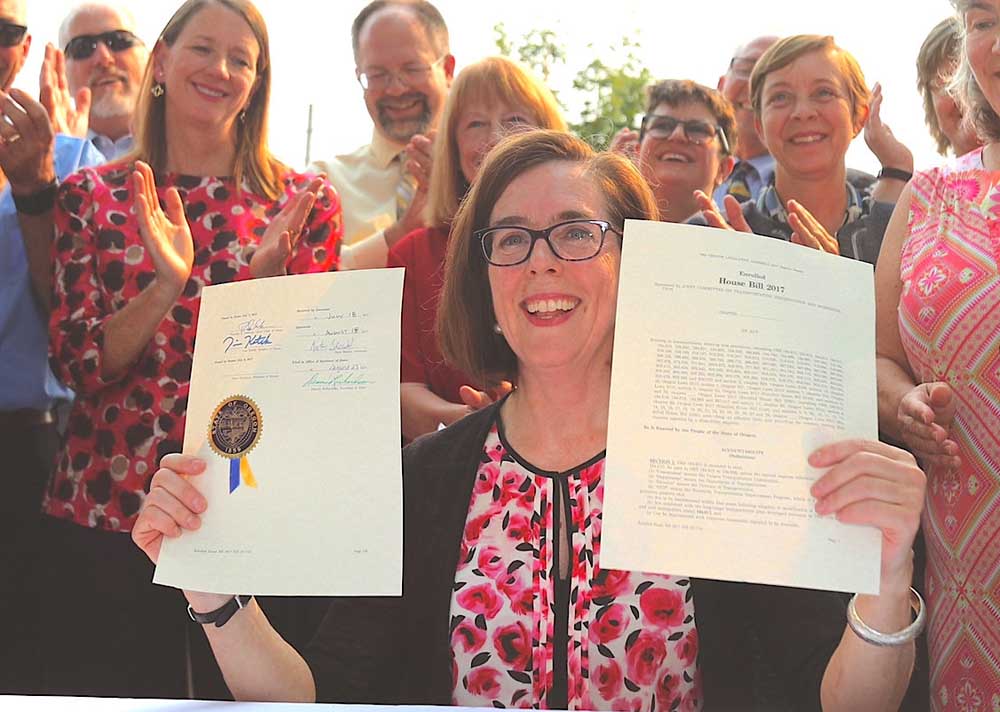Governor celebrates transportation package with statewide tour
Published 4:03 pm Tuesday, August 29, 2017

- A survey paid for by icitizen shows half of Oregonians have an unfavorable view of Gov. Kate Brown, but would reelect the Democrat incumbent by a narrow margin.
PORTLAND — Gov. Kate Brown’s tour of the state Monday and Tuesday to celebrate signing into law a $5.3 billion transportation funding package possessed the energy of a campaign blitz.
Trending
Oregon’s 38th governor stopped in Ontario, Bend and Medford Monday and Eugene and Portland Tuesday to reenact signing the bill and to highlight projects that will benefit those areas.
Her last stop was at Portland Community College’s Southeast campus at 82nd Avenue and Division Street Tuesday.
“The transportation package is truly a roadmap to Oregon’s future,” Brown told a crowd of about 200 at the campus. “Not only will it improve the safety and condition of our roads and bridges, it will support thousands of family-wage jobs and help local businesses get their goods to market more efficiently.”
Trending
Brown actually signed the legislation into law Aug. 18, the deadline to enact bills from the 2017 Legislature, which adjourned early last month.
The transportation package was a chief victory for both Democratic and Republican lawmakers during the legislative session.
As the bill appeared ready to combust over discontent among interest groups, Brown intervened to help negotiate a deal that would save the package she’d been promising to constituents for the past two years.
“Passing the transportation package was no easy feat,” Brown said Tuesday. “We faced some significant challenges this last legislative session but we worked across the aisle and toward a shared vision for a better Oregon.”
Brown, just two years into her position, already faces a challenge to her incumbency in 2018. Moderate Republican Rep. Knute Buehler, a surgeon from Bend, announced his candidacy earlier this month and is expected hit $1 million in campaign funds by the week’s end. Brown has about $1.5 million cash on hand for her campaign.
Political insiders say the transportation package gives the governor a bipartisan triumph to tout in her presumed reelection bid. (She has yet to official announce her intentions.)
Her tour of the state shows she can turn political rhetoric into results, said one statewide political operative unassociated with Brown’s campaign.
“I was very committed to delivering on a transportation package because I saw the critical importance for keeping Oregon moving and keeping our economy humming,” Brown said. “I was pleased we were able to get bipartisan support: Republicans, Democrats, urban and rural working together to deliver on this package to make Oregon a better place for all of us.”
Jim Moore, director of the Tom McCall Center for Policy Innovation at Pacific University, said transportation is unlikely to be a Top 10 issue in the gubernatorial campaign. That’s because most voters aren’t in tune with legislative developments or even whether the state or local government fixes the roads they traverse, he said.
“Transportation is kind of a political nerd sport,” Moore said. “Because of that it may or may not make a good issue at the center of that campaign.”
However, the statewide tour still gives some momentum to her campaign.
“Her face is being seen out there; she is talking to people,” Moore said. “It gives you a reason t… to go around the state. Transportation is good because it is not a natural disaster. It is: “Hi, here I am, your emissary from Salem. I have brought you something. It is classic incumbent behavior.”
Brown’s campaign funds were not used to pay for the statewide tour, said Bryan Hockaday, a press secretary in Brown’s office. He said last week he did not yet know the cost of the tour to taxpayers and was not immediately available for comment Tuesday.
The eight-year transportation plan includes staggered hikes in the gas tax, increases to registration and title fees, and new taxes on payroll, new vehicle purchases and bicycles priced more than $200. The package also calls for congestion-priced tolling at some of Portland’s bottlenecks, which could include certain lanes on Interstate 5 and Interstate 205, to pay for congestion-busting projects.
Among major projects specified in the plan are congestion relief on Highway 217, widening northbound I-205 from Powell Boulevard to Interstate 84 and initial investment in adding new lanes to I-5 through Portland’s Rose Quarter.








